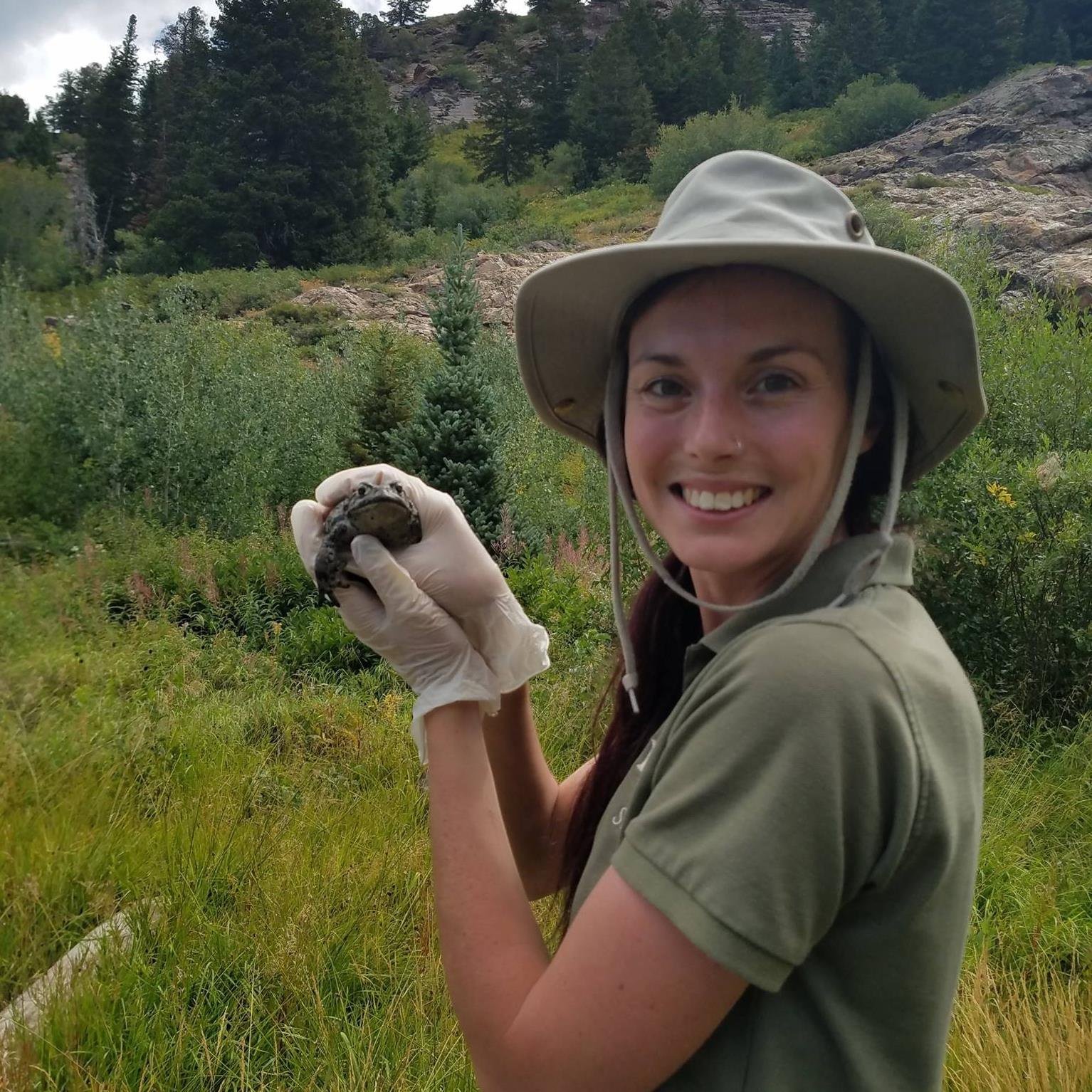A Lifelong (Warty) Love: Boreal Toads & Hogle Zoo’s Kayleigh Mullen
Hogle Zoo’s Utah Conservation Programs Supervisor Kayleigh Mullen pauses with a boreal toad on a survey.
One of our partners and a Boreal Toad Project lead, Kayleigh Mullen’s love for wildlife and wild places started at a young age.
“I grew up in a small village in rural England, and I was lucky enough to roam free through woodlands and pastures,” she reflects. “I’d find backways through the farms and woodlands to my grandma’s house, who loved walking. We would walk for miles and miles, and I think that is where my first love of being outdoors and in nature sparked from.”
This blossomed into a lifelong career, leading to her current position as Hogle Zoo’s Utah Conservation Programs Supervisor. “When I learned you could study ecology and wildlife at college level, that cemented it for me. I knew I wouldn't be content doing anything else.”
Drawn to amphibians and reptiles
Many of us remember looking for amphibians or reptiles as children, but most of us lose connection to the magic of spotting a toad’s eyes just above green water or seeing the end of a snake’s tail disappear into sagebrush. Kayleigh, however, has continued her closeness with these unique species.
“Amphibians are rooted in so many of our childhoods,” she says. “When I talk about my work in amphibian conservation, one of the most common responses is, ‘Oh, we used to see frogs all of the time growing up, but now we rarely see them.’ Most people have a connection to amphibians and wetlands without realizing it. These animals are a very overlooked group.”
Working at a zoo with charismatic megafauna—lions, elephants, and bears, for example—Kayleigh says she enjoys the challenge of getting people as excited about amphibians as they are about the charming mammals.
Mounting pressures
From habitat loss to development to fragmentation, amphibians face many risks. “As small, low mobility species,” says Kayleigh, “amphibians are hit hard even by the smallest development projects, like roads and culverts. On top of this invasive species, chytrid fungus and a changing climate just pile the pressure on.”
Boreal toad conservation at Hogle Zoo
To help address these threats to boreal toads and other amphibians, Kayleigh has been a large part of Hogle Zoo’s boreal toad conservation work, which has been running for 10 years.
“We have a mutli-pronged approach which includes outreach and education, both on Zoo grounds and with our Education team traveling to different schools across the entire state.”
A particularly exciting part of the Zoo’s work is their breed and release program. This program successfully released 64 toads last summer, and it is set to do the same next year. But releasing toads isn’t the only thing the program does. “We have conducted all kinds of habitat restoration at the release site,” Kayleigh says, “including ungulate fencing to ease grazing pressure around known breeding ponds, willow plantings, beaver dam analogues, and years of water quality data to keep track of any changes in the environment.”
Kayleigh has a large role in this work. She oversees the Zoo’s boreal toad project as a whole, meaning working with state agencies, federal agencies, and non-profit organizations like Sageland Collaborative, recruiting community scientists and interns to help in the field, surveying and monitoring populations across Utah, taking care of the assurance colony on Zoo grounds, and working with veterinary staff to hibernate and breed the toads, among many other responsibilities.
Kayleigh says she loves the variety involved in her position. “You can only plan so much of a day when you work at a zoo and when you work in the field. Sometimes there will be moose at your survey site you have to wait out, sometimes rolling thunder storms will keep you in your truck longer than anticipated, sometimes the grounds crew at the Zoo will get a big donation of flowers and staff are asked to help plant them throughout the Zoo, and sometimes a university class arrives and would like a tour. There is just so much going on and so many ways to help get people involved in conservation work!”
A community working for boreal toad conservation
Kayleigh says that the Zoo couldn't complete the conservation work it does without the strength of their partners and community.
“What I have learned since joining this field,” she notes, “is that conservation is rarely about the animals—it is about the humans in the communities surrounding those animals. Without guidance from the Utah Division of Wildlife Resources, support from Sageland Collaborative, and the hundreds of hours our community scientists put in, our boreal toad conservation work would not be nearly as robust as it is today.”
“Having our community connect with their local wildlife is important to the Zoo—not just for Utah wildlife itself, but it helps start the bigger conversation about global conservation and needed work.”
To those who might be thinking of getting involved in conservation, or simply curious, Kayleigh has a clear message: “We need you! You don't have to be a STEM major. This field is an interdisciplinary one. We need public speakers who can story tell and connect people with the work happening, artists to bring elusive and little seen creatures to life, educators, translators and legislators, and all kinds of people to help protect wildlife and conserve our wildlands.”
“If you aren't science-minded or passing that AP math class, DO NOT be discouraged. Conservation is for everyone. We just need your passion!”
A huge thank you to Kayleigh for all she does for these amazing species! You can join Kayleigh in this important work by joining our boreal toad project.
Author: Sarah Woodbury








